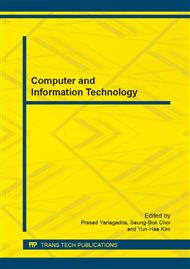[1]
Z.G. Jia, X.L. Liu, Modeling Spatial Relationships for Remote Sensing Image Processing Based on Fuzzy Set Theory. In: International Conference on Computer Science and Software Engineering, Vol. 4(2008), pp.1101-1104.
DOI: 10.1109/csse.2008.1446
Google Scholar
[2]
M.J. Egenhofer, J. Sharma, Topological Relations between Regions in R2 and Z2. In: the Third International Symposium on Large Spatial Databases, 1993, pp.316-336.
Google Scholar
[3]
D.M. Mark, M.J. Egenhofer, Modeling Spatial Relations between Lines and Regions Combining Formal Mathematical Models and Human Subjects Testing [J]. Cartography and Geographic Information Systems, 1994, Vol. 21, pp.195-212.
Google Scholar
[4]
J.M. Keller, X. Wang, Learning Spatial Relationships in Computer Vision. In: the Fifth IEEE International Conference on Fuzzy Systems, 1996, pp.118-124.
Google Scholar
[5]
J.M. Keller, X. Wang, A Fuzzy Rule-Based Approach to Scene Description Involving Spatial Relationships. Computer Vision and Image Understanding, Vol. 80 (2000), pp.21-41.
DOI: 10.1006/cviu.2000.0872
Google Scholar
[6]
S. Du, Q. Qin, Q. Wang, The spatial relations in GIS and their applications. Earth Science Frontiers, Vol. 13 (2006), pp.69-80.
Google Scholar
[7]
X. Du, J. Xiong, Equivalency evaluation model of spatial topological relations in multiple scale representation. Science of Surveying and Mapping, Vol. 32 (2007), pp.70-72.
Google Scholar
[8]
S.H. Choe, J.H. Park, S. -S. Pyo, Hierarchical Spatial Relation Based on a Contiguity Graph. International Journal of Intelligent Systems, Vol. 20 (2005), pp.867-892.
DOI: 10.1002/int.20096
Google Scholar
[9]
D. Papadias, M.J. Egenhofer, HierarchicalSpatial Reasoning about Direction Relations. GeoInformatica, Vol. 1 (2007), pp.251-273.
Google Scholar
[10]
F. Fonseca, M. Egenhofer, P. Agouris, et al., Semantic Granularity in Ontology-Driven Geographic Information Systems. Annals of Mathematics and Artificial Intelligence, Vol. 36 (2002), pp.121-151.
Google Scholar
[11]
M. Egenhofer, R. Franzosa, On the Equivalence of Topological Relations. International Journal of Geographical Information Systems, Vol. 9(1995), pp.133-152.
DOI: 10.1080/02693799508902030
Google Scholar
[12]
Q. Guo, H. Ding, H. Liu, X. Liu. Combinational Reasoning of Spatial Topological Relations between Two Areas Based on Basic Spatial Relations. Geomatics and Information Science of Wuhan University, Vol. 30(2005), pp.728-731.
Google Scholar
[13]
S. Berretti, A. Del Bimbo, and E. Vicario, Modeling Spatial Relationships between Color Sets. In: IEEE Workshop on Content-based Access of Image and Video Libraries, 2000, pp.73-77.
DOI: 10.1109/ivl.2000.853843
Google Scholar


